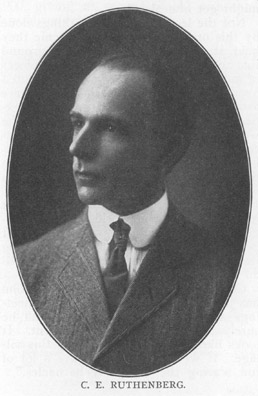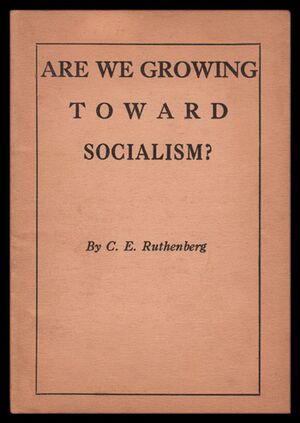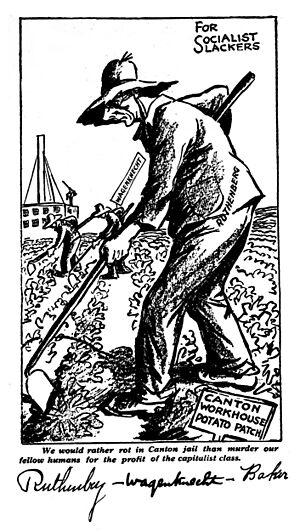C. E. Ruthenberg facts for kids
Quick facts for kids
C.E. Ruthenberg
|
|
|---|---|

Ruthenberg in 1910
|
|
| Executive Secretary of the Communist Party of America | |
| In office September, 1919 – April 18, 1920 |
|
| Preceded by | Position established |
| Succeeded by | Charles Dirba |
| Editor of The Communist | |
| In office May 1920 – May 1921 |
|
| Preceded by | Louis Fraina |
| Succeeded by | Max Cohen |
| Executive Secretary of the Workers Party of America | |
| In office December 1921 – August 1925 |
|
| Preceded by | Charles Dirba |
| Succeeded by | Party name changed |
| Executive Secretary of the Workers Communist Party of America | |
| In office August 1925 – March 1, 1927 |
|
| Preceded by | Party name changed |
| Succeeded by | Jay Lovestone |
| Personal details | |
| Born |
Charles Emil Ruthenberg
July 9, 1882 Cleveland, Ohio, U.S. |
| Died | March 1, 1927 (aged 44) Chicago, Illinois, U.S. |
| Resting place | Kremlin Wall Necropolis, Moscow |
| Political party | Communist Party USA |
| Other political affiliations |
Workers Party of America |
| Spouse | Rosaline "Rose" Nickel |
| Alma mater | Columbia University |
Charles Emil Ruthenberg (born July 9, 1882 – died March 1, 1927) was an American political leader. He helped start and lead the Communist Party USA (CPUSA). He believed in Marxism, a way of thinking about how society and the economy should be organized.
Contents
Biography
Growing up in Cleveland
Charles Emil Ruthenberg was born on July 9, 1882, in Cleveland, Ohio. His parents, Wilhelmina and August Charles Ruthenberg, were from Prussia (part of modern-day Germany). They were Lutherans, a type of Christian faith. They moved to America in 1882.
When they first arrived, Charles's father worked on the docks of the Cuyahoga River. Later, he opened a bar with his son-in-law. Young "Charlie" finished a church school in 1896. He then worked in a bookstore. At night, he studied bookkeeping and typing at a business college.
In June 1904, Ruthenberg married Rosaline "Rose" Nickel. She was also of German background. They had one son, Daniel, in 1905. During this time, Ruthenberg worked as a bookkeeper and sales manager for a publishing company. He managed over 30 salespeople.
Becoming a socialist (1908–1918)
Ruthenberg first became interested in politics through Tom L. Johnson, the mayor of Cleveland. Johnson was known for his "reform" ideas. But Ruthenberg soon wanted more radical changes. In 1908, he began to call himself a socialist. Socialists believe that society's wealth should be shared more fairly.
Ruthenberg went to Columbia University in 1903. He became involved with groups that wanted big changes. He finished Columbia Law School in 1909. That same year, he joined the Socialist Party of America (SPA).
From 1909 to 1919, Ruthenberg was an organizer and secretary for the Socialist Party in Cuyahoga County, Ohio. He also helped lead the Ohio Socialist Party. He edited two newspapers, The Cleveland Socialist and Socialist News. He also wrote for The Ohio Socialist. In 1915, he was chosen for the Socialist Party's National Committee.
Ruthenberg traveled a lot, speaking to worker groups and trade unions. He also spoke to groups against war. He wanted big, revolutionary changes in society, not just small improvements.
Ruthenberg ran for many political offices. In 1910, he ran for Ohio's state treasurer. He ran for mayor of Cleveland in 1911, 1915, 1917, and 1919. He also ran for Governor of Ohio in 1912 and for U.S. Senate in 1914. In 1916 and 1918, he ran for U.S. Congress. He never won these elections.
In 1917, Ruthenberg attended a big meeting of the Socialist Party. He helped write a plan called the St. Louis program. This plan strongly opposed America joining World War I.
After the U.S. entered the war, Ruthenberg kept speaking out against it. He was accused of breaking the Espionage Act. This law made it illegal to interfere with the military draft. He was charged with Alfred Wagenknecht and Charles Baker. They were tried in July 1917 and sentenced to one year in prison. The U.S. Supreme Court upheld their sentence. They served almost 11 months and were released in December 1918.
The Cleveland May Day Riot (1919)
After leaving prison, Ruthenberg quickly joined the growing left-wing movement. A huge event was planned for May Day in Cleveland in 1919. Thousands of marchers, many carrying red flags, planned to meet in a public square. They wanted to hear speeches and support workers' rights.
As many as 20,000 people marched, and many more watched. A riot broke out between the police and the marchers. Two marchers were killed, hundreds were hurt, and about 150 people were arrested. This event is known as the Cleveland May Day Riot. Ruthenberg was charged in connection with this event, but he was not found guilty.
Starting the Communist Party USA
Ruthenberg supported the idea of creating a new, more radical political party. He was part of a group that wanted to change the Socialist Party. But when that didn't work, he supported starting a new party.
Many groups, especially those made up of immigrants, wanted to form a Communist Party. Ruthenberg was a good choice to lead this new group. He spoke English well, which was helpful. On September 1, 1919, the Communist Party of America (CPA) was formed in Chicago. Ruthenberg was chosen as its first Executive Secretary.
For a while, there were two main communist groups in America. The Communist International (Comintern), a global communist organization, wanted them to unite. It took a few years for this to happen.
In 1920, Ruthenberg and some others left the CPA. They joined another group to form the United Communist Party (UCP). Ruthenberg was put in charge of the party's newspapers. Still, the communist movement was divided.
Finally, by the end of 1922, the groups merged. They formed a new, unified Communist Party of America. They also created a legal political party called the Workers Party of America (WPA).
During much of this time, Ruthenberg was in jail again. In October 1920, he was tried in New York for breaking a state law against "criminal anarchism." This was because of a document published by his group. He was sentenced to five years in prison. He stayed in Dannemora Prison until April 1922, when he was released on bail.
As soon as he was out, Ruthenberg became the Executive Secretary of the WPA. This party grew quickly. The underground communist party slowly disappeared. Ruthenberg remained the leader of the American Communist Party (still called the Workers Party of America) for the rest of his life.
His criminal charges were eventually overturned in July 1922. But then he faced new charges related to a secret meeting in Michigan.
The Bridgman Convention (1922)
In August 1922, a secret meeting was held at a resort in Bridgman, Michigan. The goal was to unite different communist groups. However, a government informant was at the meeting. The authorities were told about it.
Even after the groups merged, there were still disagreements among the leaders. Ruthenberg and his supporter Jay Lovestone had different ideas from William Z. Foster. Foster wanted the party to focus more on organizing American workers in unions.
Ruthenberg ran for the U.S. House of Representatives in Ohio, but he did not win.
In 1925, a leader from the Comintern told the larger group, led by Foster, to let Ruthenberg's group take control. Foster agreed. But the disagreements inside the party continued.
Ruthenberg also had a case, Ruthenberg v. Michigan, that went to the U.S. Supreme Court. This case was about his First Amendment rights. The Court voted against him. But Ruthenberg died before the ruling was officially announced, so the case was never fully published.
Death and legacy
Ruthenberg died on March 1, 1927, in Chicago. He had surgery for a serious stomach infection called peritonitis. After his death, his body was cremated. His ashes were taken to Moscow, Russia. On April 26, they were placed in the Kremlin Wall Necropolis. This is a special burial place for important people in Moscow.
Writings
Charles Ruthenberg was more of a leader and organizer than a writer of big ideas. He wrote many articles and some short books (pamphlets). He didn't publish any large books during his life. After he died, a small book of his speeches was published.
You can find many of his writings online. The Marxists Internet Archive has a lot of his articles and pamphlets.
Books and pamphlets
- Are We Growing Toward Socialism? (1917)
- Guilty? Of what?: Speeches Before the Jury (1917)
- After the War — What? (December 1918)
- A Communist Trial: Extracts from the Testimony of C.E. Ruthenberg and Closing Address to the Jury by Isaac E. Ferguson (1920)
- The Farmer-Labor United Front (1924)
- Why Every Worker Should Be a Communist and Join the Workers Party (1923)
- From the Third Through the Fourth Convention of the Workers (Communist) Party of America (1925)
- The Workers (Communist) Party: What It Stands For, Why Workers Should Join (1925)
- Voices of Revolt: Charles E. Ruthenberg. (1928)
- Ruthenberg, Communist Fighter and Leader. (1928)
Articles and leaflets
- "You Will Pay in Blood and Suffering" (April 1, 1917)
- "This is Not a War for Freedom" (May 27, 1917)
- "Greeting to the October Revolution" (November 1917)
- "On the Threshold of the New World" (April 27, 1918)
- "Forward, March!" (January 1919)
- "The Bolshevists: Grave-Diggers of Capitalism" (January 29, 1919)
- "The Bankruptcy of Democracy" (February 1, 1919)
- "Who Are the Murderers?" (May 1919)
- "The Communist Party and Its Tasks" (July 1921)
- "The Need for Open Work" (August 1921)
- "Communism in the Open Again" (February 1923)
- "An Open Challenge" (March 1923)
- "The Second Round at St. Joseph" (June 1923)
- "Role of the Workers Party" (July 1923)
- "The Revolutionary Party" (January 1924)
- "Progressive, But Not Labor" (November 1924)
- "Is the Movement Toward Class Political Action Dead?" (December 1924)
- "The Session of the Enlarged Executive Committee of the Communist International" (June 1926)
- "The Tasks of the party in the Light of the Comintern" (July 1926)
- "Capitalism Mobilizes Against the Workers" (September 1926)
- "Seven Years of the Communist Party" (September 1926)
- "Socialist Party Fights Unity of Action of Workers" (September 15, 1926)
- "What Is the Election About?" (November 1926)
- "Eugene V. Debs and the Revolutionary Labor Movement" (November 6, 1926)
- "Two Supreme Court Decisions" (November 9, 1929)
- "Many Opportunities for Building the Revolutionary Movement" (November 27, 1926)
- "The Achievements of the Party" (November 28, 1926)
- "Organization of the Unorganized and Work in the Trade Unions" (November 30, 1926)
- "The Campaign for the Labor Party" (December 1, 1926)
- "Reorganization of the Workers (Communist) Party" (December 3, 1926)
- "First Signs of a Downward Trend in Industry" (February 5, 1927)
Images for kids
See also
 In Spanish: Charles Ruthenberg para niños
In Spanish: Charles Ruthenberg para niños








